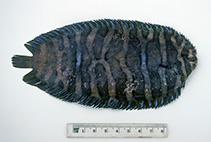| Family: |
Soleidae (Soles) |
| Max. size: |
22 cm TL (male/unsexed) |
| Environment: |
demersal; brackish; marine; depth range 3 - 43 m |
| Distribution: |
Southwest Pacific: warm-temperate New South Wales, Australia. |
| Diagnosis: |
Dorsal soft rays (total): 71-84; Anal soft rays: 61-71; Vertebrae: 43-45. This species is distinguished from its congeners by the following characters: vertebrae 43-45; dorsal-fin rays 71-84; anal-fin rays 61-71; lateral-line scales 81-89; ocular-side pigmentation pattern consists of 8-10 dark-brown to black, mostly complete crossbands on the body, with these bands noticeably wider than the alternating lighter-colored crossbands; 3 dark brown
crossbands continuous across head; 2 conspicuous white spots in longitudinal series on the ocular-side midline; 2 elongated ocular-side pectoral-fin rays of nearly equal length or with the second fin ray longer than first; small scales on bases and proximal halves of elongated ocular-side pectoral-fin rays (Ref. 76812). |
| Biology: |
Found in estuaries and harbors, usually buried in muddy substrate (Ref. 9002). Move with undulating body when disturbed, reminiscent of distasteful flatworm, thus possibly deterring predators (Ref. 9002). |
| IUCN Red List Status: |
Least Concern (LC); Date assessed: 25 January 2021 Ref. (130435)
|
| Threat to humans: |
harmless |
Source and more info: www.fishbase.org. For personal, classroom, and other internal use only. Not for publication.
